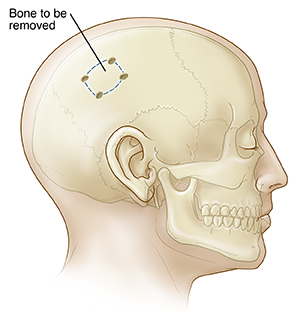Having a Craniectomy
A craniectomy is a surgery to remove a piece of your skull. It’s done to help relieve pressure in the skull when the brain swells. This increased pressure is dangerous. It can lead to brain damage or even death if not treated.
Getting ready for your surgery
Craniectomy is usually done as an emergency surgery. Because of this, you may not be able to prepare ahead of time.
Before the surgery, the healthcare team will ask about your health history and give you a physical exam. Your team will carefully watch you and work to reduce the pressure inside your skull. During this time, you may need a sedative. This is a medicine that helps you relax. You may also need breathing support with a ventilator. A ventilator is a machine that moves air in and out of the lungs.
You won’t be able to eat or drink anything before surgery. You may need imaging tests. These may include a CT scan of your head. This is an imaging test that uses a series of X-rays and a computer to create images of the inside of the body. A CT scan helps your healthcare providers get more information about your condition.
You or a family member may be asked to sign a consent form that gives permission to do the procedure. Read the form carefully. Ask questions if something is not clear.
During your surgery
The surgery is done by a neurosurgeon. This is a healthcare provider who has special training to do brain surgery. They will work with a team of specialized healthcare providers. The team will let you know what will happen during the surgery. In general, you can expect the following:
-
You will receive general anesthesia through an IV (intravenous) line. An IV line is a thin tube that is put into 1 of your veins. This will let you sleep during the surgery and not feel any pain. You may also get antibiotics through the IV line. This is to help prevent infection.
-
You may have a breathing tube down your throat during the surgery to control your breathing. Your healthcare team will watch your vital signs, such as heart rate and blood pressure.
-
Hair will be removed from an area of your scalp. The area of scalp will be cleaned.
-
The neurosurgeon will make a cut (incision) in your scalp. This is often done on the side of the skull with the most pressure.
-
The neurosurgeon will use a drill and saw to remove a large piece of your skull (bone flap). The healthcare team will carefully store the bone flap so that it can be placed back in a few weeks when the swelling is gone.
-
The neurosurgeon will make a cut in the membranes that surround your brain. They will remove blood clots, stop any bleeding and do repairs as needed.
-
In the following weeks, when the swelling has gone down, your own bone, or a metal mesh piece, or synthetic bone flap may be placed over the area. This is to help protect the brain.
-
The healthcare team will close the scalp with stitches or staples.

After your surgery
After the surgery, you’ll be in an intensive care unit (ICU). Healthcare providers will carefully watch your vital signs. You may not wake up right away. It may take some time for the brain to recover from swelling and injury. You may need days or weeks in the hospital to recover. As you recover, your healthcare team will be able to see how well the surgery worked to prevent brain damage. They will tell you more about the results to expect from your surgery.
After you wake up, you’ll be able to slowly become more active. Your healthcare team will give you directions about what you can eat and drink. If you have pain from the scalp incision, you can take pain medicine as directed.
Recovering at home
You’ll need to wear a special helmet for a while. This is to protect the area that is missing a piece of skull. It's important to wear this helmet exactly as directed to prevent injury to the area. You should not do any activities that may lead to head injury.
Follow-up care
Make sure to keep all of your follow-up appointments.
When to call your healthcare provider
Call your healthcare provider if you have any of the following:
-
Fever of 100.4°F (38°C) or higher, or as directed by your healthcare provider
-
Swelling, redness, or fluid leaking from your scalp incision
-
Pain that gets worse
-
Seizures
-
Vomiting
-
Shortness of breath